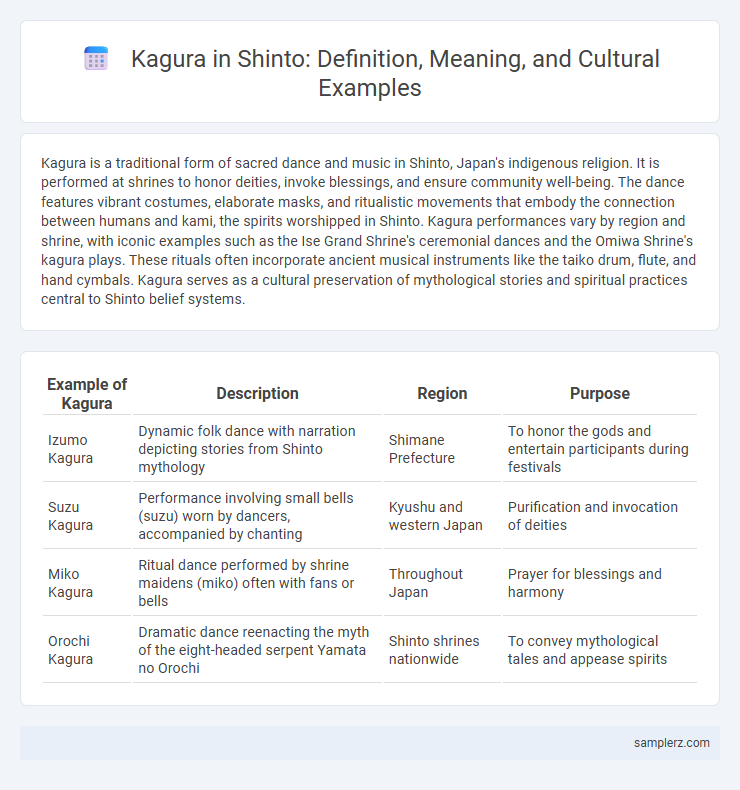Kagura is a traditional form of sacred dance and music in Shinto, Japan's indigenous religion. It is performed at shrines to honor deities, invoke blessings, and ensure community well-being. The dance features vibrant costumes, elaborate masks, and ritualistic movements that embody the connection between humans and kami, the spirits worshipped in Shinto. Kagura performances vary by region and shrine, with iconic examples such as the Ise Grand Shrine's ceremonial dances and the Omiwa Shrine's kagura plays. These rituals often incorporate ancient musical instruments like the taiko drum, flute, and hand cymbals. Kagura serves as a cultural preservation of mythological stories and spiritual practices central to Shinto belief systems.
Table of Comparison
| Example of Kagura | Description | Region | Purpose |
|---|---|---|---|
| Izumo Kagura | Dynamic folk dance with narration depicting stories from Shinto mythology | Shimane Prefecture | To honor the gods and entertain participants during festivals |
| Suzu Kagura | Performance involving small bells (suzu) worn by dancers, accompanied by chanting | Kyushu and western Japan | Purification and invocation of deities |
| Miko Kagura | Ritual dance performed by shrine maidens (miko) often with fans or bells | Throughout Japan | Prayer for blessings and harmony |
| Orochi Kagura | Dramatic dance reenacting the myth of the eight-headed serpent Yamata no Orochi | Shinto shrines nationwide | To convey mythological tales and appease spirits |
Origins and Significance of Kagura in Shinto
Kagura, rooted in ancient Shinto rituals, originates from the myth of the sun goddess Amaterasu, who was enticed from her cave through sacred dance and music. This ceremonial performance serves as a vital medium for invoking kami, expressing gratitude, and ensuring spiritual harmony between humans and the divine. Kagura's significance lies in its enduring role in Shinto shrines, preserving cultural heritage and fostering communal identity through ritualistic storytelling and worship.
Types of Kagura Performances
Kagura, a sacred Shinto theatrical dance, features diverse performance types such as Mi-kagura, which involves slow, ceremonial dances performed by shrine maidens, and O-kagura, a more elaborate, theatrical form with music and drama depicting mythological stories. Other notable forms include Sato-kagura, community-based performances blending folk dance and ritual, and Izumo-kagura, characterized by dynamic movements unique to the Izumo region. These variations highlight Kagura's significance in preserving Shinto myth and fostering spiritual connection during festivals and rituals.
Ritual Kagura: The Sacred Dances
Ritual Kagura in Shinto is a sacred dance performed to honor the kami and invite divine spirits during religious ceremonies. These dances, often accompanied by traditional music and masks, serve as a medium to connect the human and spiritual realms, preserving ancient myths and cultural heritage. Ritual Kagura's intricate movements and symbolic gestures play a crucial role in Shinto worship, maintaining the sanctity of shrine rituals across Japan.
Folk Kagura: Regional Variations
Folk Kagura in Shinto showcases rich regional variations, reflecting local myths, deities, and cultural heritage across Japan. In the San'in region, Kagura performances emphasize agricultural rituals, featuring unique drums and masks distinct to the area. The Ise region's Folk Kagura highlights the worship of Amaterasu, incorporating elaborate dance sequences that preserve ancient storytelling traditions.
Symbolic Elements in Kagura Rituals
Kagura rituals in Shinto incorporate symbolic elements such as the use of sakaki branches, which represent the sacred connection between the human world and the kami deities. The ritualistic use of masks and costumes often symbolizes ancestral spirits or mythical beings, reinforcing spiritual presence during performances. Rhythmic dance movements paired with traditional instruments like the taiko drum emphasize purification and the invocation of divine blessings.
Famous Kagura Examples Across Japan
Iwami Kagura, originating from Shimane Prefecture, exemplifies dynamic storytelling through vibrant dance and music, often depicting myths of gods and spirits. Aki Kagura in Hiroshima is renowned for its refined, classical style performed during shrine festivals to honor deities and pray for blessings. Yoshida Kagura from Kyoto engages audiences with dramatic performances featuring elaborate masks and costumes, reflecting ancient Shinto rituals and local folklore.
Costumes and Masks in Kagura Traditions
Kagura traditions in Shinto feature elaborate costumes and masks that symbolize deities and spirits, enhancing the ritual's spiritual significance. The costumes, often vibrant and intricately embroidered, include flowing robes and ornate headdresses to evoke divine presence. Masks represent various kami and mythical creatures, crafted from wood and lacquered to convey expressive, otherworldly faces integral to the ceremonial performance.
Musical Instruments Used in Kagura
Kagura performances in Shinto rituals prominently feature musical instruments such as the taiko drum, kagura suzu (a type of bell), and the fue (bamboo flute), which collectively create a sacred atmosphere. The deep resonance of the taiko sets the rhythmic foundation, while the kagura suzu's jingling tones accompany ceremonial dances, enhancing spiritual engagement. The fue's melodic lines intertwine with percussion, symbolizing communication between deities and worshippers during the kagura rites.
Kagura in Modern Shinto Festivals
Kagura performances remain a vital element in modern Shinto festivals, showcasing traditional dance and music that honor kami and ensure community blessings. These rituals incorporate sacred instruments like the taiko drum and kagura suzu bells, preserving ancient spiritual practices within contemporary celebrations. Modern interpretations often blend historical choreography with local cultural expressions, reflecting Shinto's enduring influence in Japan's cultural identity.
Preserving Kagura: Challenges and Revivals
Kagura, the sacred Shinto dance and music performance, faces challenges in preservation due to urbanization and declining local participation. Efforts to revive Kagura include community workshops, integration into cultural festivals, and documentation by cultural heritage organizations. Preservation initiatives increasingly emphasize intergenerational transmission to maintain the ritual's spiritual and cultural significance.

example of kagura in Shinto Infographic
 samplerz.com
samplerz.com